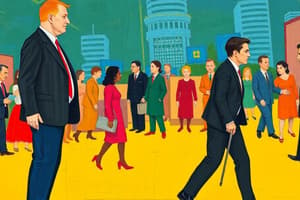Podcast
Questions and Answers
What is the concept of the Natural Rate of Unemployment?
What is the concept of the Natural Rate of Unemployment?
- A rate of unemployment with the highest consumer spending
- A rate of unemployment where job creation equals job destruction
- A rate of unemployment with the highest economic growth
- A rate of unemployment achievable without causing inflation (correct)
What does the Phillips Curve suggest about the relationship between unemployment and inflation?
What does the Phillips Curve suggest about the relationship between unemployment and inflation?
- Higher unemployment leads to higher inflation
- There is no relationship between them
- Lower unemployment leads to lower inflation
- Lower unemployment leads to higher inflation (correct)
Which policy aims to improve the match between job seekers and employment opportunities?
Which policy aims to improve the match between job seekers and employment opportunities?
- Monetary policy
- Fiscal policy
- Labor market policies (correct)
- Trade policy
What does the NAIRU (Non-Accelerating Inflation Rate of Unemployment) incorporate into its concept?
What does the NAIRU (Non-Accelerating Inflation Rate of Unemployment) incorporate into its concept?
What is the primary impact of persistent high unemployment on society?
What is the primary impact of persistent high unemployment on society?
Which macroeconomic policy involves manipulating interest rates to control inflation?
Which macroeconomic policy involves manipulating interest rates to control inflation?
What type of unemployment occurs when workers transition between jobs?
What type of unemployment occurs when workers transition between jobs?
Which type of unemployment results from a mismatch between available jobs and job seekers' skills?
Which type of unemployment results from a mismatch between available jobs and job seekers' skills?
During economic downturns, which type of unemployment typically increases?
During economic downturns, which type of unemployment typically increases?
How is the U3 unemployment rate defined?
How is the U3 unemployment rate defined?
Which method of measuring unemployment includes marginally attached workers and part-time workers due to economic reasons?
Which method of measuring unemployment includes marginally attached workers and part-time workers due to economic reasons?
What does the U6 measure include that the U3 measure does not?
What does the U6 measure include that the U3 measure does not?
Study Notes
Understanding Unemployment Through Macroeconomics
Unemployment, a cornerstone of macroeconomic analysis, refers to the situation where people who are willing and able to work are not employed. This concept is crucial in assessing the health of an economy, its productivity, and the well-being of its citizens.
Defining Unemployment
Unemployment is categorized into three types:
- Frictional unemployment: Occurs naturally as workers transition between jobs, which is a normal part of the labor market.
- Structural unemployment: Resulting from a mismatch between available jobs and the skills of job seekers, often due to technological or economic changes.
- Cyclical unemployment: Tied to the business cycle, it increases during economic downturns when demand for labor declines.
Measuring Unemployment
Unemployment rates are typically calculated by dividing the number of unemployed individuals by the labor force (the sum of employed and unemployed persons). There are two main methods of measuring unemployment:
- U3: Defined by the International Labor Organization as the number of unemployed individuals as a percentage of the labor force.
- U6: A broader measure that includes marginally attached workers (those who want to work but have not looked for employment recently) and those working part-time due to economic reasons.
Unemployment and the Macroeconomy
Unemployment is a central focus in macroeconomics, and its analysis informs crucial decisions about policies such as job creation, inflation control, and economic stability.
- The Phillips Curve: A trade-off between unemployment and inflation, indicating that lower unemployment is achievable only at the cost of higher inflation.
- The Natural Rate of Unemployment: The lowest rate of unemployment an economy can achieve without causing inflation.
- The NAIRU (Non-Accelerating Inflation Rate of Unemployment): An extension of the natural rate, incorporating the idea that the economy can tolerate a certain amount of frictional and structural unemployment without causing inflation.
The Impact of Unemployment
Unemployment has a significant impact on the well-being of society. Persistent high unemployment can lead to reduced consumer spending, decreased economic growth, and increased social issues such as poverty and crime.
Policy Responses to Unemployment
Governments and central banks employ various macroeconomic policies to tackle unemployment:
- Fiscal policy: Includes spending and taxing decisions to stimulate the economy and create jobs.
- Monetary policy: Involves manipulating interest rates to control inflation and encourage borrowing and lending.
- Labor market policies: Aims to improve the match between job seekers and employment opportunities, such as job training programs and wage subsidies.
Conclusion
Unemployment is a critical macroeconomic issue that fluctuates with the business cycle, changes in technology, and economic policies. Understanding the causes, consequences, and possible remedies of unemployment requires a deep understanding of macroeconomics and its applications.
Studying That Suits You
Use AI to generate personalized quizzes and flashcards to suit your learning preferences.
Description
Explore the fundamental concepts of unemployment in the realm of macroeconomics, including types of unemployment, measuring methods, and its impact on the economy. Delve into the policies and theories that aim to address this crucial economic issue.




